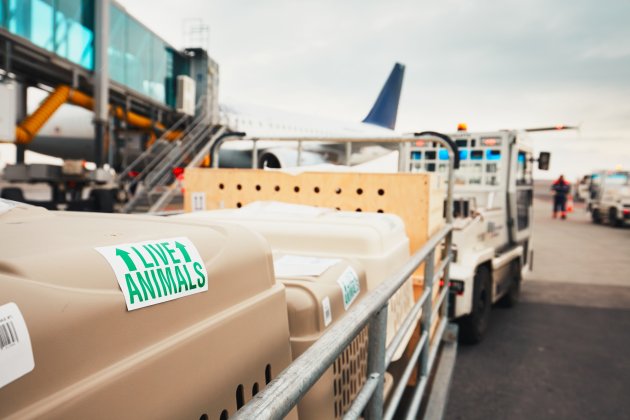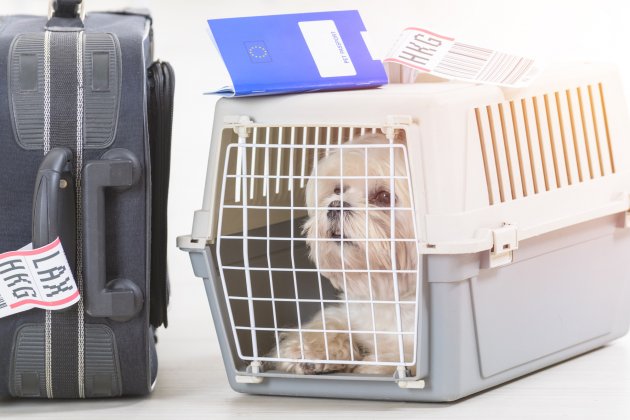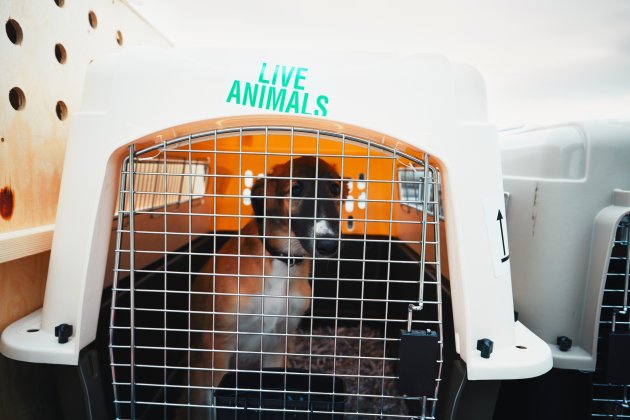The world has become more mobile, and pets are now treated as a member of the family, so it’s no wonder that we see more pet flying on airplanes. If you have traveled by plane recently, you were sure to see a few dogs at the airport. Many people are taking their pets with them on vacation. There is some risk associated with flying with your pet that everyone should be aware are present. While smaller pets are allowed on board the plane, larger dogs must be placed in cargo under the aircraft. There is more risk of flying with your pet in cargo than on the airplane with you.
Unfortunately, airlines do not accept your pets as a member of the family and require large pets to fly in cargo. Cargo can be a very unsafe place for your pets. There are many risks associated with checking your pet as cargo; such as your pet getting overheated, injured or even death.

Most common risks to your dog's health when flying in the cargo area
When your pet is in the baggage area of the plane, many things can go wrong.
Your pet’s carrier could come apart, and your pet gets lost. Unfortunately, if your pet does escape their carrier, they are not always found. Most airports are located in bustling cities, which is not an excellent place for a pet to run free. If the carrier accidentally comes open during the flight, your pet could be running loose around the cargo area and could even get seriously injured or killed. If the carrier opens on the tarmac, there are many ways your pet could get injured and may never be found again.
Advertisement
Your pet can get injured. When in cargo, there is no guarantee that another suitcase or other large item does not fall during turbulence. This fall could break your pet's cage and injure your dog. There is no one flying under the plane with your dog to make sure that they are okay for the whole flight. When the cargo door is open the airport workers are not expecting a dog to be running around free under the plane. This could cause your dog to get lost on the tarmac of the airport.
It can be very stressful when flying in cargo. Pets in cargo are placed under the plane with the luggage. There is not a person that rides in the baggage area with your pet.When the door to the baggage area is closed, your pet is not checked on until you land, and the baggage door is opened. If your pet gets stressed while on the plane, there is no one there to help calm them down. We do not want our pets to be stressed or scared. Many airlines do not allow you to sedate your pet for air travel since there is no one there to watch them, and to make sure they do not react to the medication they took.
Airports are very loudand scary for your dog. If you have ever gotten off a plane and had to walk across the tarmac, you have heard the loud sounds of the plane engines. When your pet flies in cargo, they must ride right past the roaring sounds to get on the plane. This sound can be very loud and scary for your pets. While some pets adjust well to these loud noises, many pets are already scared of being in a new environment that this noise makes their stress level increase even more.
Your pet can get overheated or too cold. The cargo hold of an airplane’s temperature is not regulated like the cabin. Your pet can get overheated or too cold very quickly. If a dog that gets overheated does not get medical attention immediately, it can die. If your pet gets too cold, hypothermia can set in, and your pet could suffer organ damage. The change in temperature while increasing in altitude can also affect your dog. It may be very hot on the ground, but once your plane reaches 20,000 feet, it is freezing.
Your pet can get on the wrong plane. Just like with luggage, your pet can end up going to the wrong destination. You may be heading to the beach for vacation, but your pet accidentally gets put on the plane beside yours and ends up on the other side of the US or even in a different country. This is the worst way to start a vacation to suddenly realize your pet did not make it on the same plane as you.
Advertisement
When to avoid flying in cargo?
There are many times that you should not let your dog fly in the cargo area of the plane.
If it is very hot or cold outside. Many airlines will only let pets travel in cargo if the outside temperature is between 80F and 40F. The cargo area of an airplane is not heated or cooled. If your plane sits on the runway, waiting for their turn to take off in the heat of summer, your pet has no way of staying cool. This can be very dangerous for your dog. A dog that gets too hot needs veterinary attention immediately.
If you have a brachycephalic dog or cat breed. A brachycephalic dog or cat is one with smooshed faces such as pugs, French bulldogs, bulldogs, Boston terrier, Persian cats, etc. These are usually not allowed to fly in cargo. Their short noses make it very difficult to breathe, and the stress of being away from their owner is not worth the risk.
If your dog is old. Older pets do not do well flying in cargo. They usually have other medical issues such as diabetes or arthritis. The stress of flying in cargo may cause their disease to flare up while they are on the plane without being able to get any help.
Your dog has a medical condition. If your dog suffers from a medical condition such as seizures, diabetes, or anxiety, they should never travel in cargo. Anything that could cause your pet a little bit of stress should be avoided in old or sick animals. Before you fly with your dog, it is best to discuss your travel plans with your veterinarian to make sure that your pet is healthy enough for travel.
Advertisement
Some tips for better airline cargo travel
There are many things that you can do to prepare your pet for airline travel. These tips and tricks will make the whole trip less stressful and more relaxing for you and your pet.Start introducing your pet to its airline crate early. Let your pet spend time in their crate at your house. An excellent way to help your pet love their carrier is with a treat. When your pet gets into their crate, give them a treat as a reward. For a few nights, let them sleep in their crate, so they learn that their crate is not an unsafe place.
Make sure to get an airline approved pet crate. All airlines will give you the maximum allowed dimensions for your crate, so make sure your pet's crate is within these dimensions. A good rule of thumb is to make sure that your pet can comfortably stand up and turn around in their crate. Make sure that their crate is securely closed. Some people will even use zip-ties to extra secure the crate. Here's everything you need to know about airline approved crates for dogs.
Write your contact information in permanent marker on the carrier. Make sure your name, contact information (that you can be reached at that day) and pet's name is on the carrier. Having your pet's name on the crate helps the people loading the pet on the plane be able to call your pet by name. This will sometimes help decrease your pet's stress if they hear their name called.
Give your pet an old tee shirt of yours to sleep on in the crate. For a few days before your trip, wear an old tee shirt around the house. This will get your scent on the tee-shirt. The day of your journey put that shirt in your dog's crate for them to curl up on while sleeping.
Follow all instructions listed on the airline’s website. All airlines have different requirements on what paperwork is needed and what needs to be in the cage with your pet. Make sure you read all the information and have it ready at check-in.
Leave your pet at home. If you are just going to be gone for a few days, sometimes it is best to leave your pets with a friend or family member or to make boarding reservations for your pet at the local pet boarding facility.
Conclusion
There are many risks associated with flying with your dog on the airplane. If your dog is small enough to fit under the seat in front of you, it reduces a lot of the extra work and stress. If you have to fly with your large dog, cargo is the only way to travel with them. There are many tips and tricks to make sure that they are safe, but there is always a risk with flying a pet in cargo. Each year we see more pets who are injured or die from flying in cargo. Many airlines are changing their policies on flying with pets to help decrease this number. While airline travel with a pet can be a little more work, by following these few tips and tricks, it can make the process very smooth and stress-free for both you and your dog.
Further reading:
- USDA APHIS. Pet Travel
- AVMA. Traveling with Your Pet
- SPCA New Zealand. How to crate train your dog?